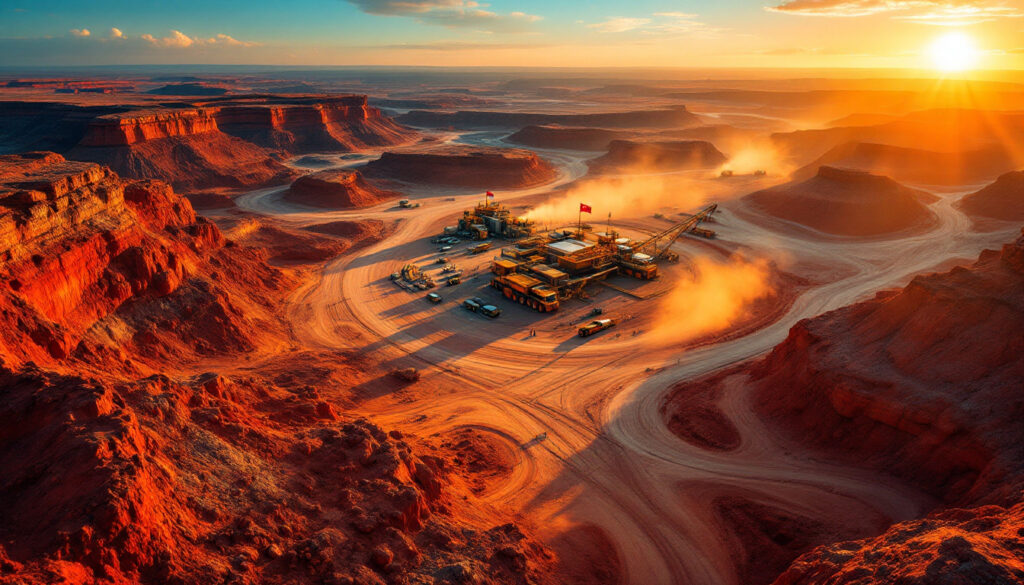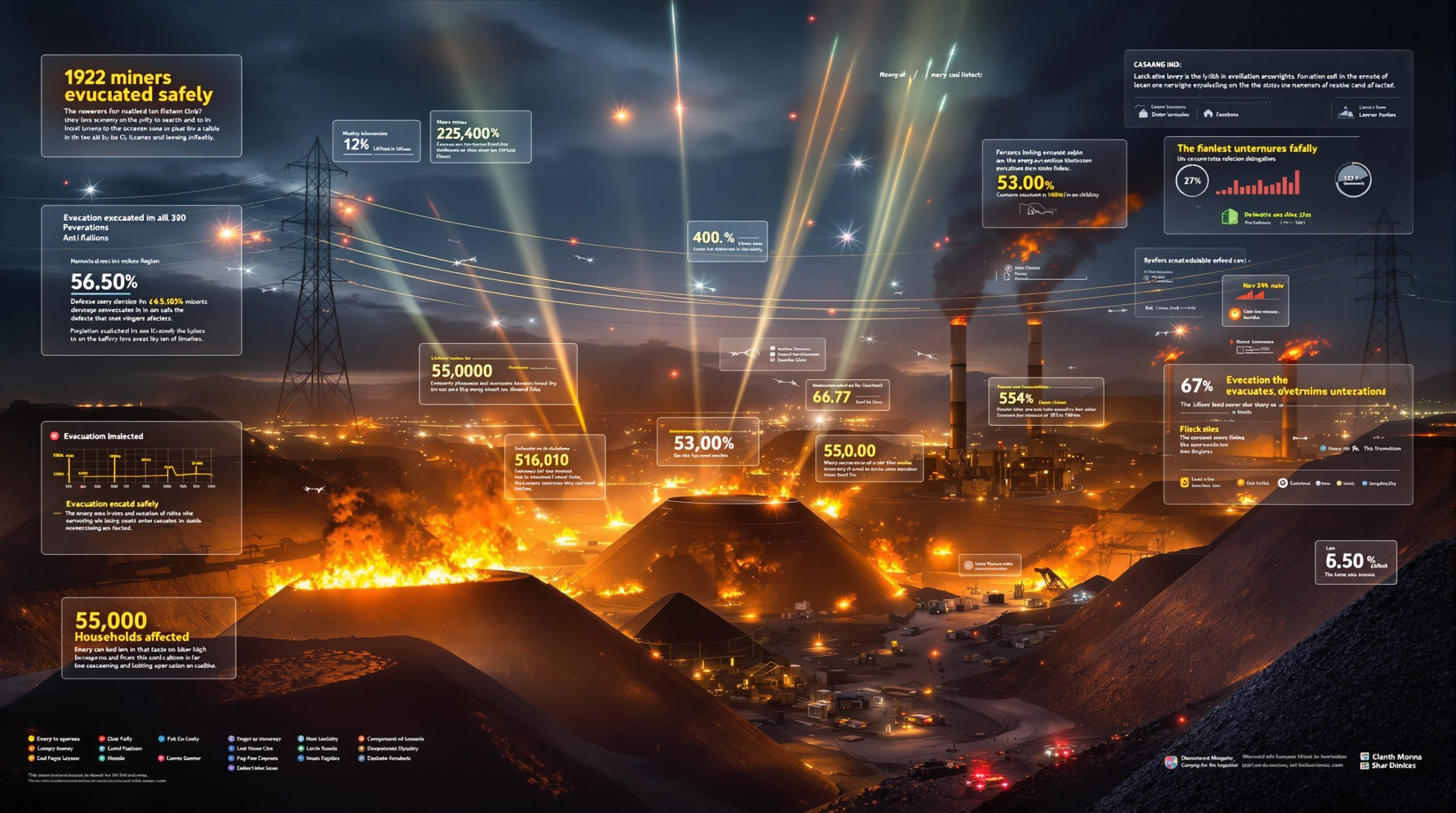Western Australia's Mining Industry: Economic Powerhouse and Employment Generator
Western Australia has firmly established itself as a global mining powerhouse, driving the state's economy and providing unprecedented employment opportunities. The state's unique geological advantages, combined with favorable government policies and sustained industry investment, have created an environment where the resources sector continues to break records and set new benchmarks.
According to the latest figures from the Western Australian Government, the mining industry evolution has reached a historic milestone with 135,693 on-site full-time equivalent positions in 2024, representing the eighth consecutive year of employment growth in this vital sector.
What Makes Western Australia a Global Mining Leader?
Western Australia's dominance in the global mining landscape stems from its extraordinary mineral wealth, sophisticated mining infrastructure, and strategic government support. The state possesses world-class deposits of iron ore in the Pilbara region, gold in the Goldfields, and increasingly important critical minerals for energy like lithium and rare earth elements scattered throughout its vast territory.
"Western Australia's unique geological advantages position us at the forefront of global mineral production," explains Professor Ross Large from the Centre for Ore Deposit and Earth Sciences. "The ancient Yilgarn Craton, forming much of the state's southwest, contains rock formations dating back 2.7 billion years, creating ideal conditions for gold mineralization."
The state's mining success also benefits from several key advantages:
- Geological diversity – From banded iron formations in the Pilbara to gold-bearing greenstone belts in the Goldfields
- Political stability – Consistent regulatory frameworks that support long-term investment
- World-class infrastructure – Dedicated rail networks, specialized ports, and purpose-built mining communities
- Technical expertise – Concentration of mining technology innovation and skilled workforce
- Proximity to Asian markets – Strategic location for exporting to key customers in China, Japan, and South Korea
The combination of these factors has enabled Western Australia to develop a mining sector that not only dominates Australia's resource production but stands as a global leader across multiple commodities.
How Has Mining Employment Grown in Western Australia?
Record-Breaking Employment Figures
The Western Australian resources sector has achieved an extraordinary employment milestone, with 135,693 on-site full-time equivalent positions recorded in 2024. This represents not just a new record, but the continuation of an eight-year growth trend that has seen mining in Western Australia expand consistently since 2016.
"There is no better place in the world to get a quality job than in Western Australia's resources sector," stated Premier Roger Cook at the announcement of these figures. "The continued growth in employment opportunities reflects the strength and resilience of our mining industry."
This employment growth has occurred despite global economic challenges, demonstrating the fundamental strength of Western Australia's mining sector and its ability to create sustainable jobs across multiple commodity segments.
Key Employment Contributors by Commodity
Employment growth has been distributed across several key mining segments:
| Commodity | Approximate Employment | Key Regions |
|---|---|---|
| Iron Ore | 45,000+ | Pilbara |
| Gold | 32,000+ | Goldfields, Mid West |
| Lithium | 18,500+ | Pilbara, Southwest |
| Nickel | 14,000+ | Goldfields, Kalgoorlie |
| Alumina/Bauxite | 10,000+ | Darling Range, Kwinana |
Iron ore operations remain the largest employment generator, with major producers like Rio Tinto, BHP, and Fortescue employing tens of thousands across their Pilbara operations. The sector's employment strength stems from both the scale of operations and the ongoing capital investment in maintaining and expanding production capacity.
Gold mining continues as a strong employment contributor, with operations spread across the Goldfields region and extending into the Mid West. The sector benefits from relatively stable gold prices and Australia's position as the world's second-largest gold producer.
Perhaps most notable has been the rapid employment growth in lithium mining, where Western Australia has emerged as the world's leading producer. The Greenbushes mine in the state's Southwest, operated by Talison Lithium, is the world's largest hard-rock lithium mine and has substantially increased its workforce to meet surging global demand for battery materials.
What Investment Trends Support WA's Mining Growth?
Current Investment Landscape
The Western Australian resources sector attracted approximately $32 billion in investment during 2024, maintaining similar levels to previous years despite global economic uncertainties. This sustained capital commitment demonstrates continued confidence in the state's mining potential and supportive regulatory environment.
"Western Australia's resources sector continues to set new benchmarks for investment and employment," noted Mines Minister David Michael. "The ongoing capital flow into our mining industry reflects both current strength and future potential."
Investment has been strategically directed across several priorities:
- Brownfield expansions of existing operations
- Processing infrastructure to capture more value onshore
- Automation and digitalization to improve productivity
- Environmental management systems for sustainable operations
- Critical minerals projects supporting the energy transition
Significantly, investment patterns have begun shifting toward minerals essential for low-carbon technologies, with lithium, rare earths, and nickel receiving increased attention from both established miners and new market entrants.
Future Investment Pipeline
Beyond current investments, the Western Australian resources sector has secured commitments for approximately $48 billion in future mining, petroleum, and associated infrastructure projects. This robust pipeline indicates strong long-term industry confidence and suggests continued employment growth in coming years.
Investment analyst Sarah Thompson from RBC Capital Markets explains: "What's particularly impressive about Western Australia's investment pipeline is its diversification across both traditional strengths like iron ore and emerging investment opportunities 2025 in battery minerals. This balanced approach provides resilience against commodity price cycles."
Major planned investments include:
- Iron ore replacement projects to maintain production levels
- Expanded lithium processing to capture more value from raw materials
- Nickel sulphide developments targeting battery-grade production
- Renewable energy infrastructure for mining operations
- Port and rail expansions to support increased export volumes
The scale of this investment pipeline suggests Western Australia's mining sector will continue generating substantial employment opportunities well into the future, particularly as projects move from construction to operational phases.
How Does Exploration Activity Support Mining's Future?
Near-Record Exploration Expenditure
Exploration activity in Western Australia remains exceptionally strong, with mineral exploration insights showing expenditure reaching $2.5 billion in 2024 – approaching previous record levels. This substantial investment in discovering new resources underscores the industry's long-term commitment to the state and confidence in future mineral prospects.
"Robust exploration spending across Western Australia reinforces our position as a global minerals leader," Premier Cook emphasized when discussing the exploration figures. "Today's exploration becomes tomorrow's mines and jobs."
Exploration activity provides two critical functions for the mining industry's future:
- Resource replenishment – Replacing depleted reserves to maintain production levels
- New discovery potential – Identifying entirely new deposits to drive future growth
The Western Australian Department of Mines, Industry Regulation and Safety (DMIRS) reports that exploration license applications have increased by 22% compared to the previous year, indicating growing interest in the state's mineral potential despite the maturity of many mining districts.
Focus Areas for Exploration
Exploration efforts are strategically focused on several key commodities and regions:
-
Gold exploration remains dominant, accounting for approximately 40% of exploration spending. Activities concentrate on the Eastern Goldfields, but also extend into less developed regions like the Paterson Province where recent discoveries have sparked renewed interest.
-
Iron ore exploration continues despite the maturity of the Pilbara iron province, with companies seeking higher-grade deposits that can command premium prices in increasingly quality-conscious markets.
-
Nickel and cobalt exploration has intensified, particularly in the established nickel provinces near Kalgoorlie and Kambalda. The focus has shifted toward sulphide deposits that can produce battery-grade materials with lower processing costs.
-
Copper exploration has increased significantly, driven by forecasted supply deficits and growing demand from electrification. The Paterson Province in particular has attracted major players following Rio Tinto's Winu discovery and the development of Newcrest's Havieron project.
-
Critical minerals exploration has expanded dramatically, particularly for lithium and rare earth elements. The Pilgangoora and Wodgina lithium districts continue attracting investment, while rare earth exploration has intensified in the state's midwest region.
Resource geologist Dr. Marcus Willson notes: "Western Australia's exploration success rate remains among the world's highest, reflecting both the quality of the geological terranes and the sophisticated exploration techniques employed by companies operating here."
What Makes Mining Jobs in WA "Quality Employment"?
Competitive Compensation and Benefits
Mining positions in Western Australia typically offer substantially above-average compensation packages, comprehensive benefits, and structured career advancement opportunities. According to the Australian Bureau of Statistics, the average full-time mining salary in Western Australia exceeds $140,000 annually – approximately 67% higher than the state's average full-time wage across all industries.
Premier Roger Cook specifically highlighted the "quality" nature of mining employment: "These aren't just jobs; they're quality careers that provide financial security, professional development, and long-term stability."
The compensation advantage extends beyond base salaries to include:
- Generous superannuation contributions (typically 12-15%)
- Performance bonuses linked to production and safety targets
- Comprehensive health insurance and family benefits
- Housing allowances or subsidized accommodation
- Education and professional development funding
- Flexible work arrangements including compressed schedules
For fly-in, fly-out (FIFO) workers, additional benefits often include paid travel expenses, accommodation, meals, and recreational facilities during on-site rotations.
Skills Development and Career Pathways
The mining sector provides extensive training and skills development programs, creating pathways for workers to advance their careers within the industry. Major companies like Rio Tinto, BHP, and Fortescue Metals Group have established structured development frameworks that enable employees to progress from entry-level positions to specialized technical roles or management positions.
"The mining industry has transformed its approach to workforce development," explains Tanya Barden, Director of Workforce Planning at the Chamber of Minerals and Energy Western Australia. "Companies now view skills development as a strategic investment rather than simply a compliance requirement."
Key skills development initiatives include:
- Apprenticeship programs in electrical, mechanical, and fabrication trades
- Graduate development programs for engineering and geology professionals
- Operations traineeships for equipment operation and processing roles
- Leadership development pathways for supervisory positions
- Indigenous employment and training programs
- Technical certification in specialized mining disciplines
The industry has also partnered with educational institutions across Western Australia to develop tailored training programs that directly align with industry needs, ensuring graduates possess immediately applicable skills.
Regional Economic Impact
Mining employment generates significant economic multiplier effects in regional communities, supporting additional jobs in service industries, retail, hospitality, and construction. Economic analysis by KPMG suggests that each direct mining job creates approximately 3.4 additional jobs in the broader economy through supply chain effects and consumption spending.
This broader economic impact strengthens regional development across Western Australia, particularly in communities like Karratha, Port Hedland, Kalgoorlie, and Newman where mining forms the economic foundation.
The regional benefits extend beyond direct employment to include:
- Infrastructure development that serves broader community needs
- Support for local businesses through procurement policies
- Community investment programs funded by mining companies
- Enhanced educational and healthcare services
- Improved transportation links between regional centers
These community-wide benefits further enhance the "quality" nature of mining employment, as workers contribute to building stronger, more sustainable regional communities.
How Does WA's Mining Sector Support the Global Energy Transition?
Critical Minerals Production
Western Australia's mining industry is strategically positioned to supply critical minerals essential for the global energy transition. The state has emerged as the world's leading source of lithium, producing approximately 49% of global supply, while also developing significant production capacity for nickel, cobalt, rare earth elements, and other minerals crucial for renewable technologies.
"Western Australia's resources sector is well placed to support the energy transition," stated Mines Minister David Michael. "Our critical minerals production is becoming increasingly vital to global decarbonization efforts."
The state's contribution to energy transition minerals includes:
| Mineral | Global Ranking | Primary Use in Energy Transition |
|---|---|---|
| Lithium | 1st | Lithium-ion batteries for EVs and storage |
| Nickel | 4th | Battery cathodes, hydrogen production |
| Rare Earths | Emerging | Permanent magnets for wind turbines, EVs |
| Cobalt | 5th | Battery cathodes for stability |
| Alumina | 1st | Lightweight materials for EVs, solar frames |
The Greenbushes lithium mine in Western Australia's southwest remains the world's largest hard-rock lithium operation, while Pilbara Minerals and Mineral Resources have rapidly expanded their lithium production capacities in the Pilbara region.
Professor Dudley Kingsnorth, rare earths expert from Curtin University, explains: "Western Australia possesses not just the mineral resources for the energy transition, but also the technical capability and stable governance that makes it a preferred supplier for manufacturers increasingly concerned about ethical sourcing."
Sustainable Mining Practices
The Western Australian mining industry is increasingly adopting sustainable mining practices, reducing environmental impacts while maintaining production efficiency. These initiatives align with global ESG (Environmental, Social, and Governance) expectations and support the transition to cleaner energy systems.
Key sustainability initiatives include:
- Renewable energy integration – Major miners including Rio Tinto, BHP, and Fortescue have committed to installing solar and wind generation at their operations, with Fortescue targeting net-zero emissions by 2030
- Water management improvements – Advanced water recycling systems reducing freshwater consumption in water-scarce regions
- Biodiversity protection – Sophisticated rehabilitation programs restoring native ecosystems after mining
- Community partnerships – Collaborative approaches with Traditional Owners ensuring mining benefits flow to Indigenous communities
- Electrification of equipment – Transitioning from diesel to electric machinery to reduce emissions
The state government has supported these efforts through streamlined approvals for renewable energy projects at mine sites and recognition programs for environmental excellence in the resources sector.
"The mining industry recognizes that its future license to operate depends on demonstrating environmental leadership," notes Dr. Laura Smith, Sustainability Director at the Minerals Council of Australia. "Western Australian operations are increasingly setting global benchmarks for sustainable mining practices."
What Challenges Does WA's Mining Sector Face?
Workforce Shortages and Skills Gaps
Despite record employment numbers, the industry continues to face significant challenges in recruiting skilled workers for specialized roles. The Chamber of Minerals and Energy Western Australia estimates the sector currently faces a shortage of approximately 40,000 workers, with particularly acute gaps in electrical trades, heavy mobile equipment maintenance, process operations, and professional roles including mining engineers and geologists.
This skills gap could potentially constrain future growth if not adequately addressed through training and immigration pathways. The challenge has been exacerbated by national workforce shortages across multiple sectors and lingering impacts from restricted international mobility during the pandemic period.
Industry responses include:
- Increased automation to reduce labor requirements
- Enhanced retention strategies including improved work schedules
- Accelerated training programs to fast-track skills development
- Targeted immigration initiatives for critical skills
- Greater diversity recruitment targeting underrepresented groups
- Partnerships with universities and technical colleges
Infrastructure Constraints
As mining operations expand into new regions, infrastructure limitations including transportation, power supply, and water access can create bottlenecks that impact operational efficiency and growth potential.
The Pilbara region faces particularly significant infrastructure challenges, with port capacity constraints potentially limiting iron ore export growth. Similar constraints affect emerging mining regions where basic infrastructure may be underdeveloped or absent entirely.
Key infrastructure challenges include:
- Limited port capacity for bulk commodity exports
- Rail congestion in established mining corridors
- Inadequate water resources in arid mining regions
- Transmission infrastructure gaps for renewable energy integration
- Housing shortages in regional mining centers
- Digital connectivity limitations in remote operations
Addressing these infrastructure gaps requires coordinated investment from both government and industry, often with timeframes extending beyond individual mining project development schedules.
Market Volatility
Commodity price fluctuations present ongoing challenges for mining operations, requiring strategic planning and operational flexibility to maintain profitability through market cycles. Recent price volatility has been particularly pronounced for lithium, where prices declined over 80% from 2022 peaks before showing signs of stabilization.
Resource economist Dr. Mark Thompson explains: "Western Australia's mining sector faces the classic challenge of capital-intensive operations in cyclical markets. Companies must balance growth investments during favorable price environments while maintaining sufficient financial resilience for inevitable downturns."
Strategies for managing market volatility include:
- Operational cost discipline focusing on lowest-quartile production costs
- Diversification across multiple commodities to balance portfolio risk
- Strategic use of hedging to secure price certainty for portions of production
- Staged development approaches allowing flexibility to adjust expansion timing
- Balance sheet strength with conservative debt levels
- Value-added processing to capture premium product pricing
These approaches help Western Australian mining operations navigate commodity cycles while maintaining employment stability and continuing essential capital investments.
What Are the Safety Considerations in WA's Mining Industry?
Regulatory Framework
Western Australia maintains stringent safety regulations for mining operations through the Mines Safety and Inspection Act and associated regulations administered by the Department of Mines, Industry Regulation and Safety (DMIRS). This comprehensive regulatory framework establishes mandatory requirements for risk management, equipment maintenance
Want to Spot Major Mineral Discoveries Before the Market Does?
Take advantage of Discovery Alert's proprietary Discovery IQ model that instantly identifies significant ASX mineral discoveries and transforms complex data into actionable insights for investors. Explore how historic discoveries have generated substantial returns by visiting Discovery Alert's dedicated discoveries page and position yourself ahead of the market.




